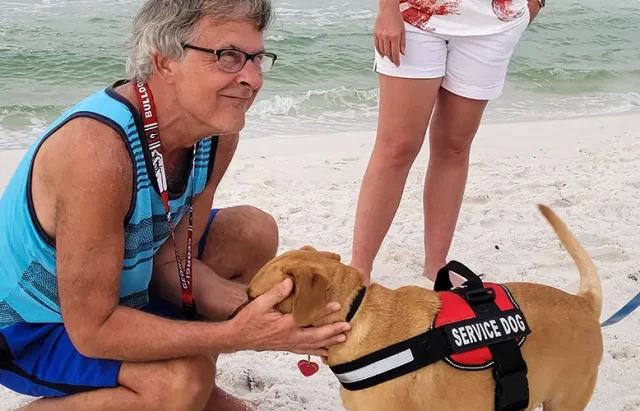
Northwest Battle Buddies knows the value that these dogs bring to their handlers, specifically, in this case, American Veterans who live with PTSD. With the support of an NWBB service dog, Veterans can overcome the debilitating symptoms of PTSD and start living the life they deserve, with freedom and independence; an essential factor is being able to travel again, see family, and experience the world. The dog “battle buddies” are professionally trained to sense anxiety and help the Veteran reduce the systems through a series of actions, among other important roles.
While the public hears negative stories about service animals and travel, a recent study shows that the public welcomes service animals and understands their critical role in helping their partners successfully handle travel. Regarding service dogs in particular, the U.S. Department of Transportation states that “Airlines are required to recognize dogs as service animals and accept them for transport on flights to, within, and from the United States.” ShareAmerica.com estimates that there are about 500,000 service dogs in the US; these well-trained companies are the ultimate travel partners for many.
For those planning to travel with a service animal, here are some essential tips to make it as stress-free as possible:
- Contact the airline ahead of time.
As of January 2021, the Department of Transportation requires pre-travel forms to be filled out for all passengers traveling with a service dog – DOT Transportation Forms. It’s always best to check with the airline beforehand to ensure the appropriate paperwork has been compiled and policies are clear. Remember that different airlines have varying policies for traveling with service dogs. Contact your airline in advance to understand their requirements and inform them about your service dog.
- Dress for Success
Service dogs must be certified or go through a professional training program and, in some instances, must wear a vest or other appropriate identification that indicates they’re service dogs. The airline staff consider harnesses, vets, and tags to distinguish them from other working animals.
- Manners (and Training) Always Matter
Airlines are permitted to deny transport to a service dog if it causes a significant disruption in the cabin or at the airport gate areas, violates safety requirements like being too heavy or oversized for a particular cabin, or poses a threat to the health and safety of others. Ensure your service dog is well-trained and behaves appropriately in public spaces. This is crucial for a positive travel experience.
- Arrive Early and Feed Mindfully
To lower travel stress, travelers should plan to get to the airport early. This allows extra time to do one last visit to the “dog relief station” – and, of course, it’s important to take it easy on the dog food before the flight.
- Extra Support is Available
Travelers with disabilities and medical conditions may call the “TSA Cares” toll-free helpline at 1-855-787-2227. Call before traveling and get answers regarding procedures, policies, and more.
- Bring Your Papers
Carry necessary documentation, such as a letter from your healthcare provider confirming your need for a service dog.
- Prepare for Security Screening
Be prepared for security screening procedures. Notify security personnel in advance that you have a service dog, and follow their instructions. Be patient and allow extra time for screening.
- Keep your Dog Comfortable
Prioritize your service dog’s health and comfort during the journey. Dogs are more comfortable traveling without a full stomach or bladder; feed and water lightly before the trip. If dehydration is a concern, ice chips on the plane are a great option. For a flight, bring essentials like water, food, and any required medications. Pack travel-friendly gear for your service dog, including collapsible bowls and a comfortable travel mat. Familiar items can help your dog feel more at ease in new environments.
- Accommodations
When booking accommodations, inform hotels or other lodgings about your service dog. Ensure they are aware of any specific needs you or your dog may have.
- Emergency Plan
Have a plan in case of emergencies, including contact information for local veterinarians and awareness of nearby pet-friendly facilities.





